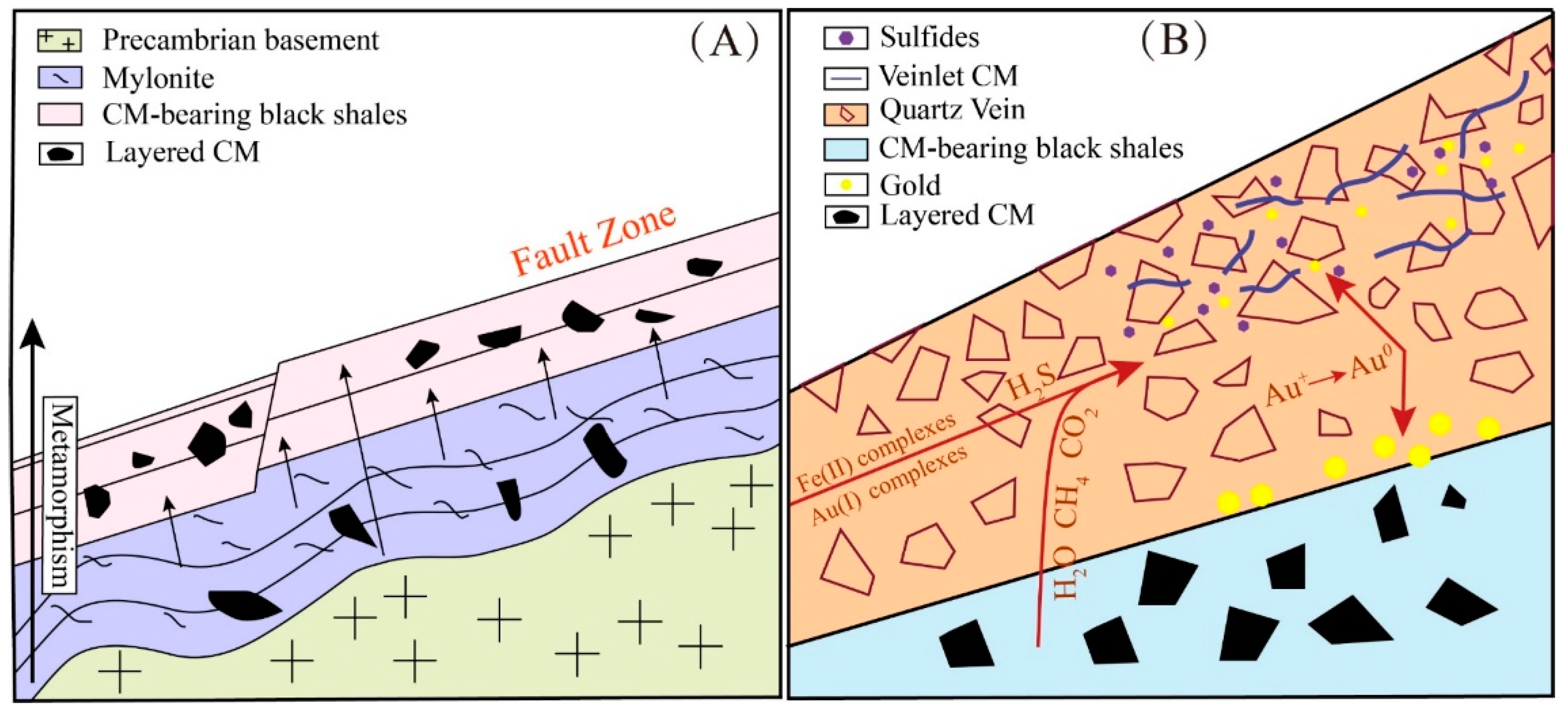Genesis of Two Types of Carbonaceous Material Associated with Gold Mineralization in the Bumo Deposit, Hainan Province, South China
Abstract
1. Introduction
2. Regional Geology
3. Ore Deposit Geology
4. Samples and Analytical Methods
4.1. Petrography and Scanning Electron Microscopy
4.2. Raman Carbonaceous Material Geothermometer
4.3. X-Ray Diffractometry (XRD)
4.4. Carbon Stable Isotopes
5. Results
5.1. Raman Spectra of CM
5.2. XRD Patterns of Layered CM
5.3. Stable Carbon Isotopic Analysis of Layered CM
6. Discussion
6.1. The Genesis of Layered and Veinlet CM
6.2. Implication for Gold Mineralization
7. Conclusions
Supplementary Materials
Author Contributions
Funding
Acknowledgments
Conflicts of Interest
References
- Hu, S.; Evans, K.; Craw, D.; Rempel, K.; Bourdet, J.; Dick, J.; Grice, K. Raman characterization of carbonaceous material in the Macraes orogenic gold deposit and metasedimentary host rocks, New Zealand. Ore Geol. Rev. 2015, 70, 80–95. [Google Scholar] [CrossRef]
- Mirasol-Robert, A.; Grotheer, H.; Bourdet, J.; Suvorova, A.; Grice, K.; McCuaig, T.C.; Greenwood, P.F. Evidence and origin of different types of sedimentary organic matter from a Paleoproterozoic orogenic Au deposit. Precambrian Res. 2017, 299, 319–338. [Google Scholar] [CrossRef]
- Kříbek, B.; Sýkorová, I.; Machovič, V.; Knésl, I.; Laufek, F.; Zachariáš, J. The origin and hydrothermal mobilization of carbonaceous matter associated with Paleoproterozoic orogenic-type gold deposits of West Africa. Precambrian Res. 2015, 270, 300–317. [Google Scholar] [CrossRef]
- Berge, J. Paleoproterozoic, turbidite-hosted, gold deposits of the Ashanti gold belt (Ghana, West Africa): Comparative analysis of turbidite-hosted gold deposits and an updated genetic model. Ore Geol. Rev. 2011, 39, 91–100. [Google Scholar] [CrossRef]
- Cox, S.F.; Sun, S.S.; Etheridge, M.A.; Wall, V.J.; Potter, T.F. Structural and geochemical controls on the development of turbidite-hosted gold quartz vein deposits, Wattle Gully mine, central Victoria, Australia. Econ. Geol. 1995, 90, 1722–1746. [Google Scholar] [CrossRef]
- Craw, D.; Windle, S.J.; Angus, P.V. Gold mineralization without quartz veins in a ductile-brittle shear zone, Macraes Mine, Otago Schist, New Zealand. Miner. Depos. 1999, 34, 382–394. [Google Scholar] [CrossRef]
- Large, R.R.; Bull, S.W.; Maslennikov, V.V. A Carbonaceous Sedimentary Source-Rock Model for Carlin-Type and Orogenic Gold Deposits. Econ. Geol. 2011, 106, 331–358. [Google Scholar] [CrossRef]
- Steadman, J.A.; Large, R.R. Synsedimentary, diagenetic, and metamorphic pyrite, pyrrhotite, and marcasite at the Homestake BIF-hosted gold deposit, South Dakota, USA: Insights on Au-As ore genesis from textural and LA-ICP-MS trace element studies. Econ. Geol. 2016, 111, 1731–1752. [Google Scholar] [CrossRef]
- Craw, D.; MacKenzie, D.; Grieve, P. Supergene gold mobility in orogenic gold deposits, Otago Schist, New Zealand. N. Z. J. Geol. Geophys. 2015, 58, 123–136. [Google Scholar] [CrossRef]
- Upton, P.; Craw, D. Modelling the role of graphite in development of a mineralised mid-crustal shear zone, Macraes mine, New Zealand. Earth Planet. Sci Lett. 2008, 266, 245–255. [Google Scholar] [CrossRef]
- Liang, X.Q. The origin and geology of the tuwaishan gold deposit in hainan province. Geol. Bull. China 1992, 2, 11. (In Chinese) [Google Scholar]
- Xia, Y.; Wu, X.; Yang, Y. Fluid inclusion studies of gold deposits in the Gezhen shear zone, Hainan Province, China. Chin. J. Geochem. 1995, 14, 371–380. (In Chinese) [Google Scholar] [CrossRef]
- Ding, S.J. The tectonic evolution of the gezhen fault zone and its gold meneralization series. Contrib. Geol. Miner. Resouc. Res. 1994, 3, 1–8. (In Chinese) [Google Scholar]
- Xu, D.; Wang, Z.; Wu, C.; Zhou, Y.; Shan, Q.; Hou, M.; Fu, Y.; Zhang, X. Mesozoic gold mineralization in Hainan Province of South China: Genetic types, geological characteristics and geodynamic settings. J. Asian Earth Sci. 2017, 137, 80–108. [Google Scholar] [CrossRef]
- Li, J.; Li, H.; Li, S. Bifurcations of travelling wave solutions for the generalized Kadomtsev–Petviashili equation. Chaos, Solitons Fractals 2004, 20, 725–734. (In Chinese) [Google Scholar] [CrossRef]
- Wang, Z.; Xu, D.; Hu, G.; Yu, L.; Wu, C.; Zhang, Z.; Cai, J.; Shan, Q.; Hou, M.; Chen, H. Detrital zircon U–Pb ages of the Proterozoic metaclastic-sedimentary rocks in Hainan Province of South China: New constraints on the depositional time, source area, and tectonic setting of the Shilu Fe–Co–Cu ore district. J. Asian Earth Sci. 2015, 113, 1143–1161. [Google Scholar] [CrossRef]
- Chen, B.L. Geochemical tracer studies on the isotopes from the gold deposits, Hainan. J. Earth 1996, 3, 302–312. (In Chinese) [Google Scholar]
- Xu, D.R.; Xia, B.; Li, P.C.; Chen, G.H.; Ma, C.; Zhang, Y.Q. Protolith natures and U–Pb sensitive high mass-resolution ion microprobe (SHRIMP) zircon ages of the metabasites in Hainan Island, South China: Implications for geodynamic evolution since the late Precambrian. Isl. Arc 2007, 16, 575–597. [Google Scholar] [CrossRef]
- Xu, D.; Wang, Z.; Cai, J.; Wu, C.; Bakun-Czubarow, N.; Wang, L.; Chen, H.; Baker, M.J.; Kusiak, M.A. Geological characteristics and metallogenesis of the shilu Fe-ore deposit in Hainan Province, South China. Ore Geol. Rev. 2013, 53, 318–342. [Google Scholar] [CrossRef]
- Zou, S.; Yu, L.; Yu, D.; Xu, D.; Ye, T.; Wang, Z.; Cai, J.; Liu, M. Precambrian continental crust evolution of Hainan Island in South China: Constraints from detrital zircon Hf isotopes of metaclastic-sedimentary rocks in the Shilu Fe–Co–Cu ore district. Precambrian Res. 2017, 296, 195–207. [Google Scholar] [CrossRef]
- Li, X.; Hanguang, L.; Yijun, Z.; Huiyu, Z.; Aijun, P. Diagenesis and Mineralization of Gold Deposits in Gezhen Gold Ore Belt, Hainan. Miner. Depos. 2002, 21, 719–722. [Google Scholar]
- Mingguo, Z.; Shuhai, Z.; Guoqing, L. The Gezhen auriferous shear zone and related metallogenic series in western Hainan Island. Miner. Depos. 1996, 4, 2–10. [Google Scholar]
- Xu, D.R.; Liang, X.Q.; Cheng, G.H.; Huang, Z.; Hu, H. Research on the geochemistry and genesis of mesoproterozoic granites on hainan island. Geotectonica et Metallogenia 2001, 25, 420–433. (In Chinese) [Google Scholar]
- Chen, Y. Hercynian and Indosinian Structureal Overprinting and 40Ar-39Ar Geochronology of Hainan Island-South China. Ph.D. Thesis, The Chinese Academy of Sciences, Beijing, China, 2006. [Google Scholar]
- Wang, P.; Kaneda, H.; Ding, S.; Zhang, X.; Liao, X.; Dong, F.; Li, Z.; Liu, X.; Lai, Y. Geology and mineralogy of the Baolun hydrothermal gold deposit in the Hainan Island, South China. Resour. Geol. 2006, 56, 157–166. [Google Scholar] [CrossRef]
- Liang, X.Q. Sm-Nd Ages of the Precambrian Granitic-Greenstone Series in Hainan Island and their Geological Significance. Acta Petrol. Sin. 1995, 1, 71–76. (In Chinese) [Google Scholar]
- Rao, D.; Xiang-ding, H.; Shao-xiong, T.U. Metallogenetic evolution of the Gezhen gold deposit belt in western Hainan Island, China: With the main deposits in Erjia-Bumo area as examples. Geol. Miner. Resour. South China 1996, 3, 12–22. (In Chinese) [Google Scholar]
- Li, X.; Li, Z.; Li, W.; Wang, Y. Initiation of the Indosinian Orogeny in South China: Evidence for a Permian magmatic arc on Hainan Island. J. Geol. 2006, 114, 341–353. [Google Scholar] [CrossRef]
- Yu, L.; Zou, S.; Cai, J.; Xu, D.; Zou, F.; Wang, Z.; Wu, C.; Liu, M. Geochemical and Nd isotopic constraints on provenance and depositional setting of the Shihuiding Formation in the Shilu Fe–Co–Cu ore district, Hainan Province, South China. J. Asian Earth Sci. 2016, 119, 100–117. [Google Scholar] [CrossRef]
- Ding, S. Gezhen detachment fault zone and its mineralization, the west hainan province. Contrib. Geol. Miner. Resour. Res. 1991, 1, 28–37. (In Chinese) [Google Scholar]
- Liu, W.; Chen, Y.; Wu, E.; Liu, Y.; Jiang, H.; Huang, Q. Geochemical Characteristics and Significance of REE in Bumo Gold Deposit. Jinshu Kuangshan/Metal Mine 2013, 3, 28–37. (In Chinese) [Google Scholar]
- Yu, S.J. Geological Characteristics and Genesis of the Baoban Gold Deposit, in Ductile Shear Zone-Type Gold Deposits in the Cathysian Block; Science Press: Beijing, China, 1992. [Google Scholar]
- Zhou, Y.; Hou, M.; Xu, D.; Shan, Q.; Hu, G.; Yu, L.; Zhang, J.; Wu, C. Gold Ore Deposits in the Gezhen Metallogenic Belt, Hainan Province of South China: An Example of Orogenic-Type Deposit? Acta Geol. Sin.-Engl. Ed. 2014, 88, 338–339. [Google Scholar] [CrossRef]
- Liu, M. Analysis on the Metallogenic Regularities and Resources Potential of the Bumo Gold Deposit in Hainan Island, South China. Master’s Thesis, Chinese Academy of Sciences, Beijing, China, 2018. (In Chinese). [Google Scholar]
- Zhou, J.; Han, P.; Liu, L.; Tian, Q.H.; Li, D.C. Characteristics of the Bumo Gold Field, Hainan Island, China and Gold Exploration Through Soil Geochemical Surveys. Resour. Geol. 2007, 57, 76–89. [Google Scholar] [CrossRef]
- Lewan, M.D.; Bjorøy, M.; Dolcater, D.L. Effects of thermal maturation on steroid hydrocarbons as determined by hydrous pyrolysis of Phosphoria Retort Shale. Geochim. Cosmochim. Acta 1986, 50, 1977–1987. [Google Scholar] [CrossRef]
- Pye, K.; Krinsley, D.H. Petrographic examination of sedimentary rocks in the SEM using backscattered electron detectors. J. Sediment. Res. 1984, 54, 877–888. [Google Scholar] [CrossRef]
- Beyssac, O.; Goffé, B.; Chopin, C.; Rouzaud, J.N. Raman spectra of carbonaceous material in metasediments: A new geothermometer. J. Metamorph. Geol. 2002, 20, 859–871. [Google Scholar] [CrossRef]
- Rahl, J.M.; Anderson, K.M.; Brandon, M.T.; Fassoulas, C. Raman spectroscopic carbonaceous material thermometry of low-grade metamorphic rocks: Calibration and application to tectonic exhumation in Crete, Greece. Earth Planet. Sci. Lett. 2005, 240, 339–354. [Google Scholar] [CrossRef]
- Sharma, H.S.S.; Carmichael, E.; McCall, D. Fabrication of SERS substrate for the detection of rhodamine 6G, glyphosate, melamine and salicylic acid. Vib. Spectrosc. 2016, 83, 159–169. [Google Scholar] [CrossRef]
- Coelho, A.A.; Cheary, R.W.; Smith, K.L. Analysis and Structural Determination of Nd-Substituted Zirconolite-4M. J. Solid State Chem. 1997, 129, 346–359. [Google Scholar] [CrossRef]
- Parker, P.L. The biogeochemistry of the stable isotopes of carbon in a marine bay. Geochim. Cosmochim. Acta 1964, 28, 1155–1164. [Google Scholar] [CrossRef]
- Orberger, B.; Vymazalova, A.; Wagner, C.; Fialin, M.; Gallien, J.P.; Wirth, R.; Pasava, J.; Montagnac, G. Biogenic origin of intergrown Mo-sulphide- and carbonaceous matter in Lower Cambrian black shales (Zunyi Formation, southern China). Chem. Geol. 2007, 238, 213–231. [Google Scholar] [CrossRef]
- Lahfid, A.; Beyssac, O.; Deville, E.; Negro, F.; Chopin, C.; Goffé, B. Evolution of the Raman spectrum of carbonaceous material in low-grade metasediments of the Glarus Alps (Switzerland). Terra Nova 2010, 22, 354–360. [Google Scholar] [CrossRef]
- Nakamura, Y.; Akai, J. Microstructural evolution of carbonaceous material during graphitization in the Gyoja-yama contact aureole: HRTEM, XRD and Raman spectroscopic study. J. Miner. Petrol. Sci. 2013, 108, 131–143. [Google Scholar] [CrossRef][Green Version]
- Binu-Lal, S.S.; Kehelpannala, K.V.W.; Satish-Kumar, M.; Wada, H. Multistage graphite precipitation through protracted fluid flow in sheared metagranitoid, Digana, Sri Lanka: Evidence from stable isotopes. Chem. Geol. 2003, 197, 253–270. [Google Scholar] [CrossRef]
- Leventhal, J.S.; Grauch, R.I.; Threlkeld, C.N.; Lichte, F.E.; Harper, C.T. Unusual organic matter associated with uranium from the Claude Deposit, Cluff Lake, Canada. Econ. Geol. 1987, 82, 1169–1176. [Google Scholar] [CrossRef]
- Burhan, R.Y.P.; Trendel, J.M.; Adam, P.; Wehrung, P.; Albrecht, P.; Nissenbaum, A. Fossil bacterial ecosystem at methane seeps. Geochim. Cosmochim. Acta 2002, 66, 4085–4101. [Google Scholar] [CrossRef]
- Oohashi, K.; Hirose, T.; Shimamoto, T. Shear-induced graphitization of carbonaceous materials during seismic fault motion: Experiments and possible implications for fault mechanics. J. Struct. Geol. 2011, 33, 1122–1134. [Google Scholar] [CrossRef]
- Jehlička, J.; Urban, O.; Pokorný, J. Raman spectroscopy of carbon and solid bitumens in sedimentary and metamorphic rocks. Spectrochim. Acta Part A: Mol. Biomol. Spectrosc. 2003, 59, 2341–2352. [Google Scholar] [CrossRef]
- Wu, Y.; Evans, K.; Fisher, L.A.; Zhou, M.; Hu, S.; Fougerouse, D.; Large, R.R.; Li, J. Distribution of trace elements between carbonaceous matter and sulfides in a sediment-hosted orogenic gold system. Geochim. Cosmochim. Acta 2020, 276, 345–362. [Google Scholar] [CrossRef]
- Shaoxiong, T.; Yanjun, G. Ore-forming fluids and stable isotope geochemistry of several gold deposits in southwestern hainan island. Miner. Depos. 1993, 4, 338–348. (In Chinese) [Google Scholar]
- Dissanayake, C.B.; Chandrajith, R. Sri Lanka-Madagascar Gondwana linkage: Evidence for a Pan-African mineral belt. J. Geol. 1999, 107, 223–235. [Google Scholar] [CrossRef]
- Kresse, C.; Lobato, L.M.; Hagemann, S.G.; Figueiredo E Silva, R.C. Sulfur isotope and metal variations in sulfides in the BIF-hosted orogenic Cuiabá gold deposit, Brazil: Implications for the hydrothermal fluid evolution. Ore Geol. Rev. 2018, 98, 1–27. [Google Scholar] [CrossRef]
- Manning, C.E.; Shock, E.L.; Sverjensky, D.A. The chemistry of carbon in aqueous fluids at crustal and upper-mantle conditions: Experimental and theoretical constraints. Rev. Mineral. Geochem. 2013, 75, 109–148. [Google Scholar] [CrossRef]
- Goldfarb, R.; Baker, T.; Dube, B.; Groves, D.I.; Hart, C.J.; Gosselin, P. Distribution, Character and Genesis of Gold Deposits in Metamorphic Terranes; Society of Economic Geologists: Littleton, CO, USA, 2005. [Google Scholar]
- Almodóvar, G.R.; Sáez, R.; Pons, J.M.; Maestre, A.; Toscano, M.; Pascual, E. Geology and genesis of the Aznalcóllar massive sulphide deposits, Iberian Pyrite Belt, Spain. Miner. Depos. 1997, 33, 111–136. [Google Scholar] [CrossRef]
- Hu, S.; Evans, K.; Craw, D.; Rempel, K.; Grice, K. Resolving the role of carbonaceous material in gold precipitation in metasediment-hosted orogenic gold deposits. Geology 2017, 45, 167–170. [Google Scholar] [CrossRef]
- Kirilova, M.; Toy, V.G.; Timms, N.; Halfpenny, A.; Menzies, C.; Craw, D.; Beyssac, O.; Sutherland, R.; Townend, J.; Boulton, C. Textural changes of graphitic carbon by tectonic and hydrothermal processes in an active plate boundary fault zone, Alpine Fault, New Zealand. Geol. Soc. Lond. Spec. Publ. 2018, 453, 205–223. [Google Scholar] [CrossRef]
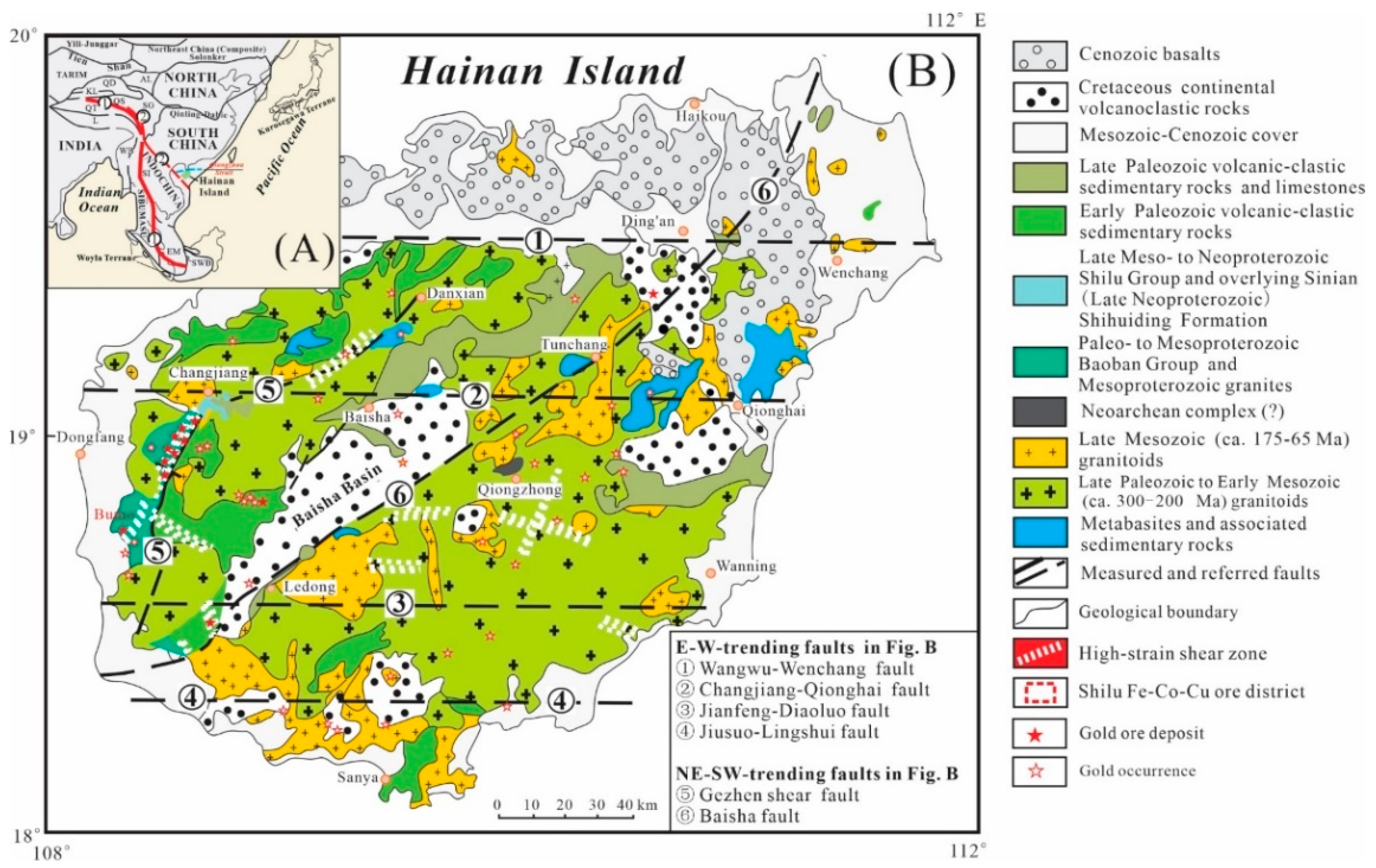
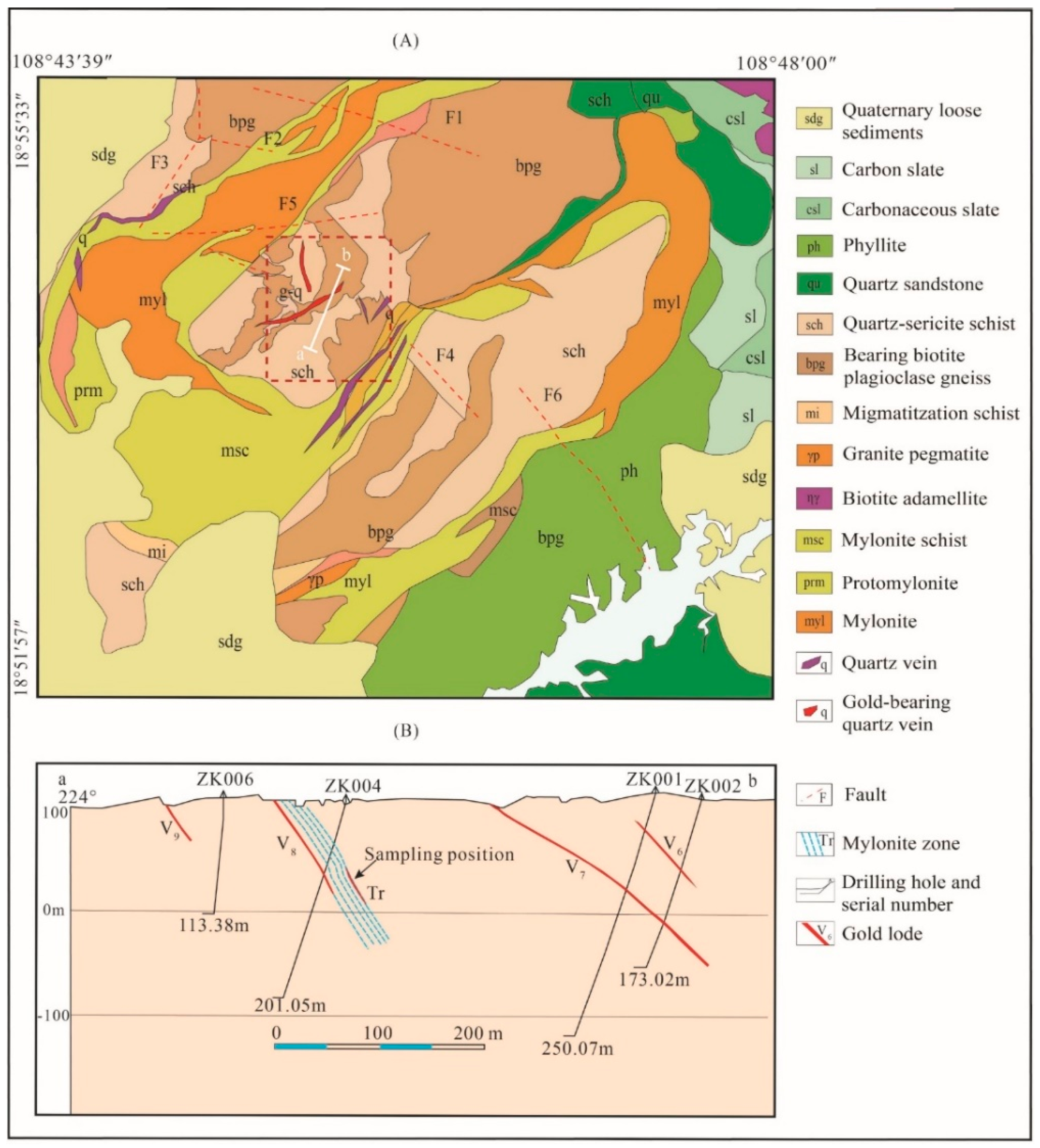
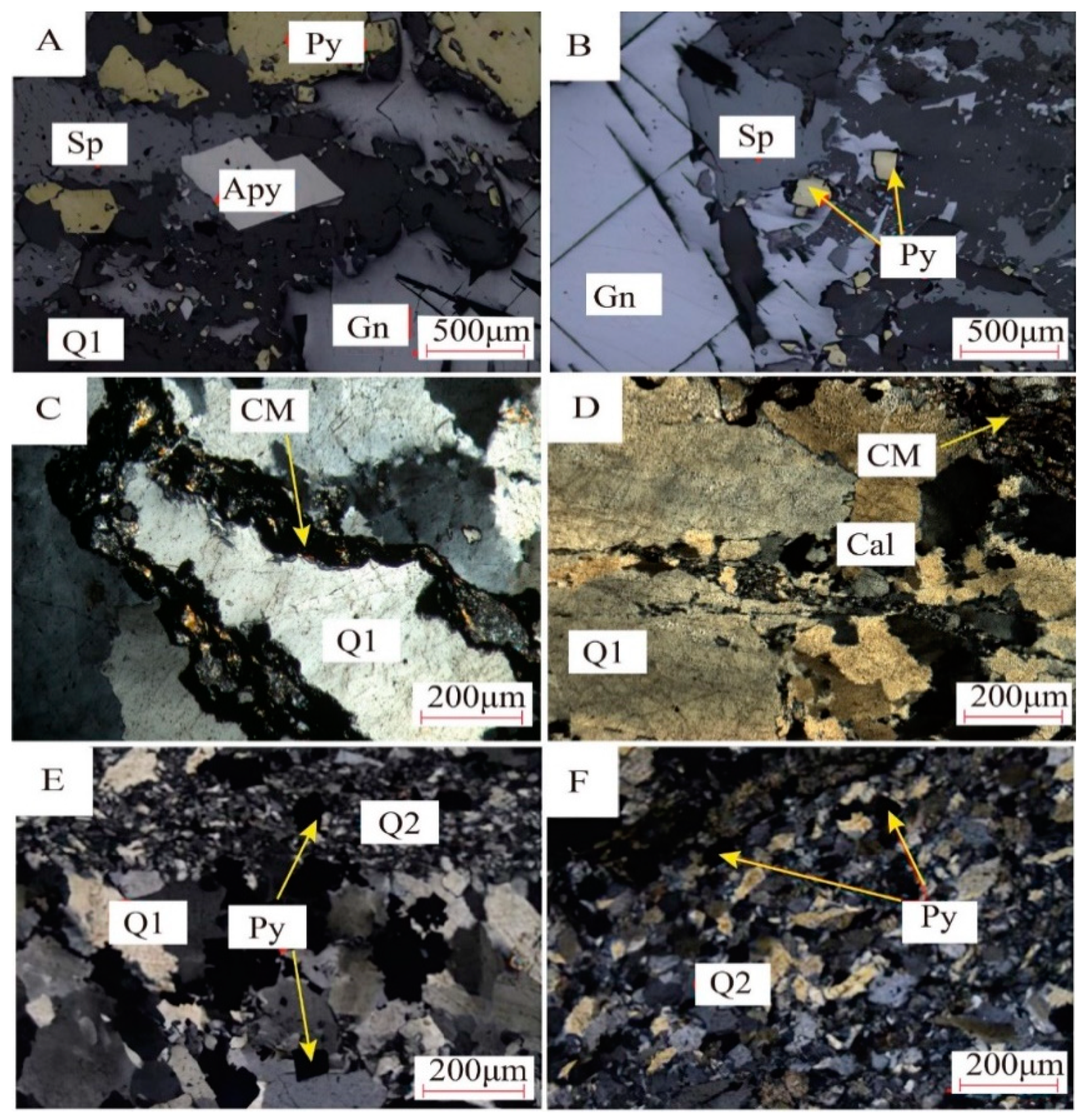
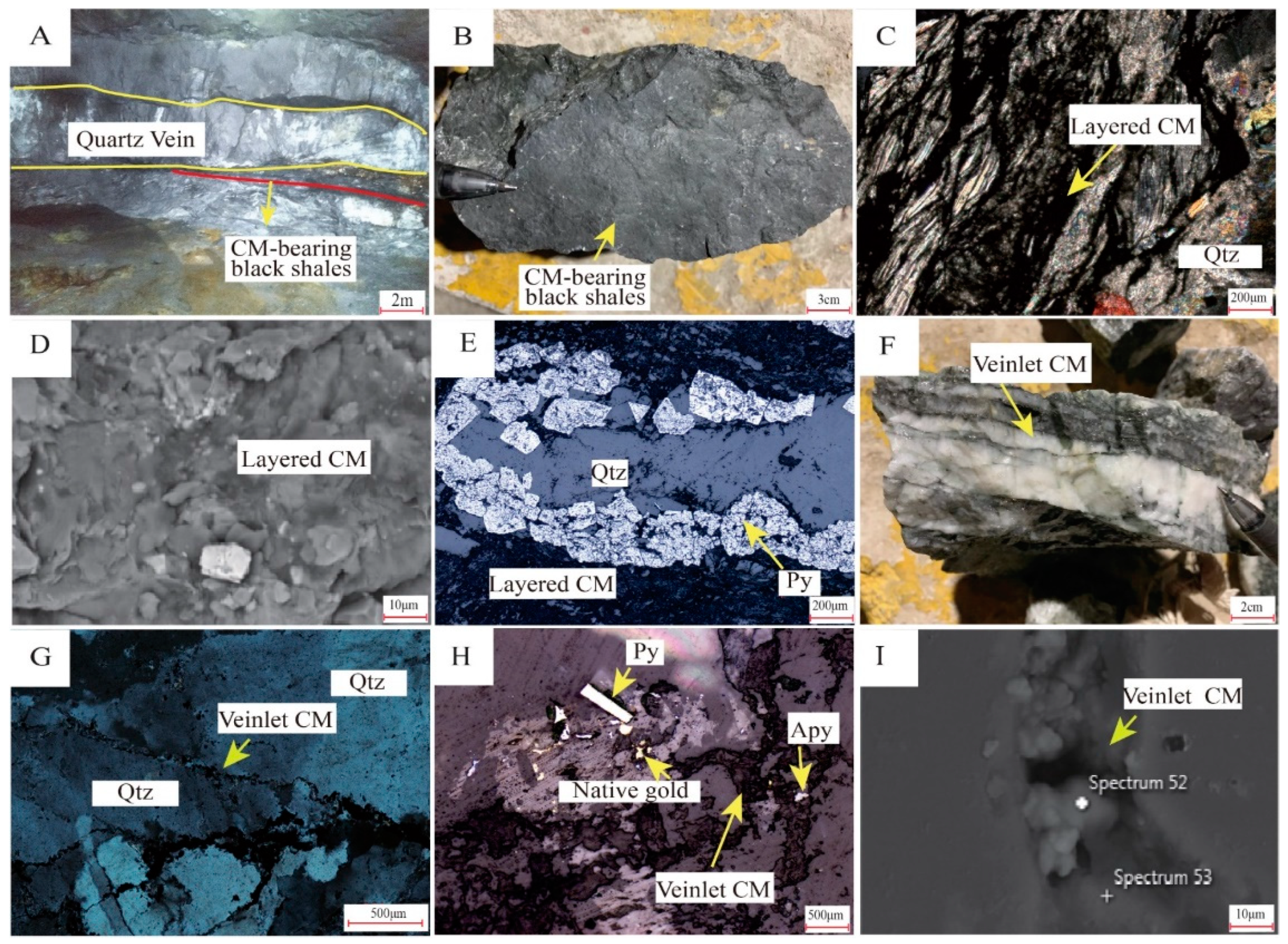
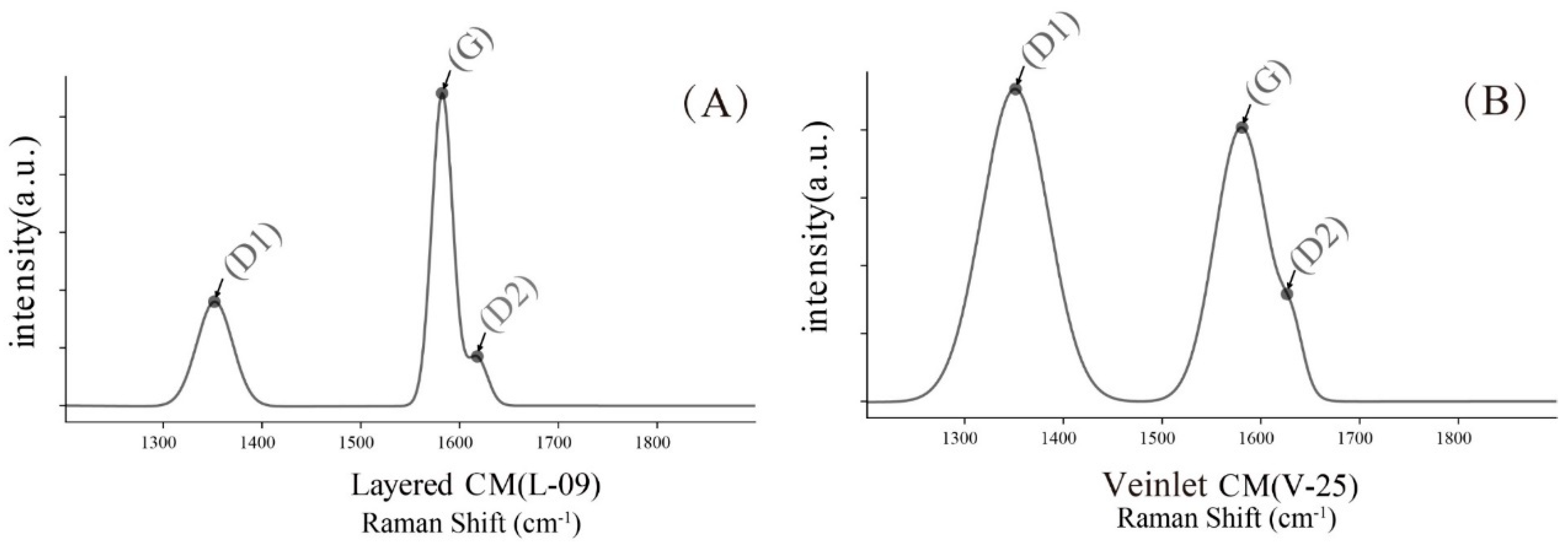

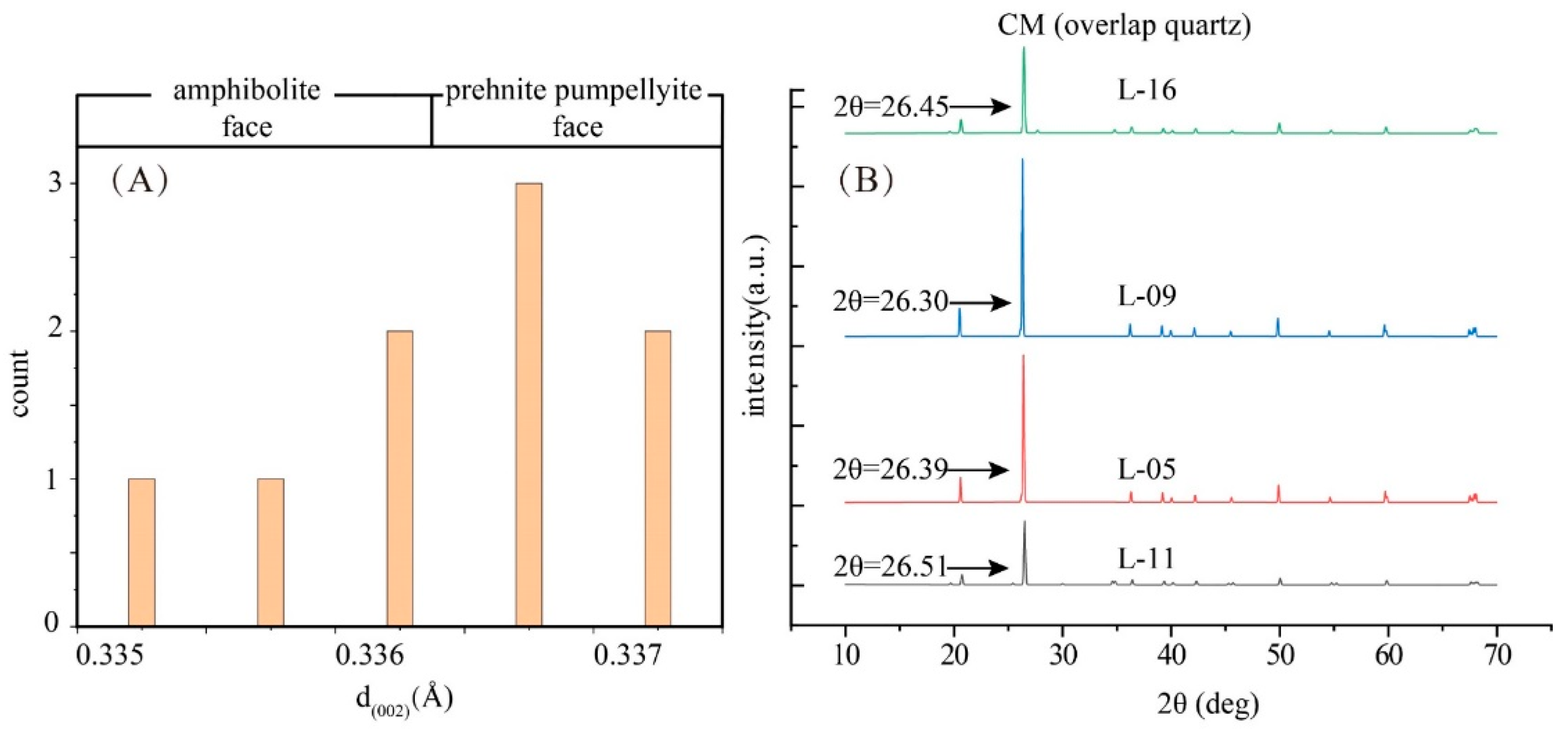
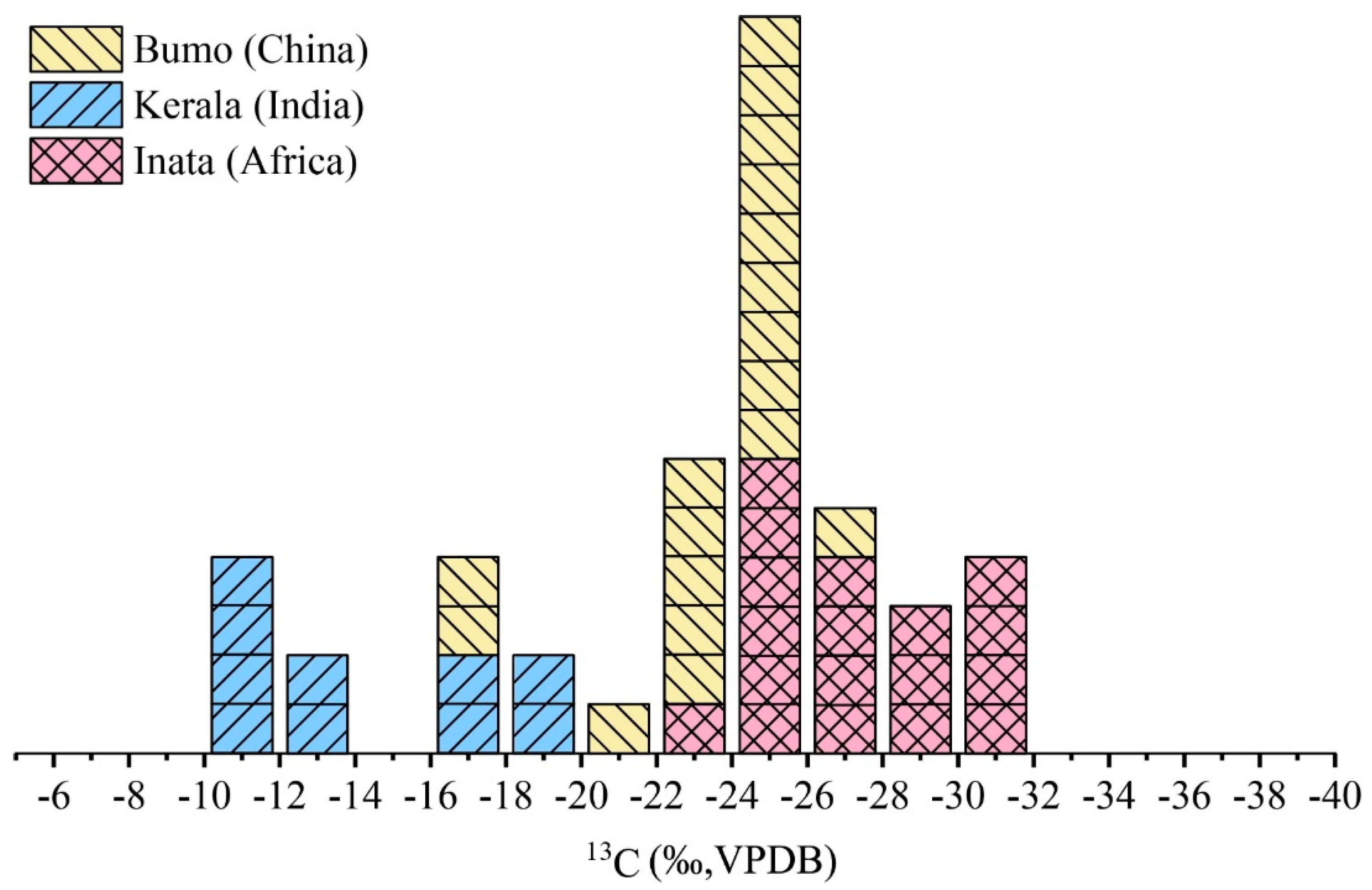
© 2020 by the authors. Licensee MDPI, Basel, Switzerland. This article is an open access article distributed under the terms and conditions of the Creative Commons Attribution (CC BY) license (http://creativecommons.org/licenses/by/4.0/).
Share and Cite
Ding, Z.; Deng, T.; Xu, D.; Li, Z.; Zou, S.; Li, L.; Xu, K.; Hai, Y.; Ma, W. Genesis of Two Types of Carbonaceous Material Associated with Gold Mineralization in the Bumo Deposit, Hainan Province, South China. Minerals 2020, 10, 708. https://doi.org/10.3390/min10080708
Ding Z, Deng T, Xu D, Li Z, Zou S, Li L, Xu K, Hai Y, Ma W. Genesis of Two Types of Carbonaceous Material Associated with Gold Mineralization in the Bumo Deposit, Hainan Province, South China. Minerals. 2020; 10(8):708. https://doi.org/10.3390/min10080708
Chicago/Turabian StyleDing, Zhengpeng, Teng Deng, Deru Xu, Zenghua Li, Shaohao Zou, Lirong Li, Ke Xu, Yan Hai, and Wen Ma. 2020. "Genesis of Two Types of Carbonaceous Material Associated with Gold Mineralization in the Bumo Deposit, Hainan Province, South China" Minerals 10, no. 8: 708. https://doi.org/10.3390/min10080708
APA StyleDing, Z., Deng, T., Xu, D., Li, Z., Zou, S., Li, L., Xu, K., Hai, Y., & Ma, W. (2020). Genesis of Two Types of Carbonaceous Material Associated with Gold Mineralization in the Bumo Deposit, Hainan Province, South China. Minerals, 10(8), 708. https://doi.org/10.3390/min10080708



